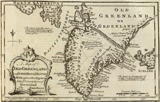Northern Sea Treasures
Traveling to North America
Lost sunken treasure may be found all around the world, even as we look to regions outside of warm tropical zones frequented by merchants and explorers. For thousands of years, routes in the Mediterranean Sea connected Africa to Europe and Asia, allowing Romans and Greeks to trade with Egyptians and eventually reach India. Then, Britannia established a sea route following the coastline from Great Britain through the Strait of Gibraltar, connecting northern lands with the Mediterranean's prosperity.

Viking expeditions found passage to the west, visiting Iceland and Greenland. Archaeological findings indicate around 1000 CE, the Norse established a small settlement on the coast of Newfoundland, Canada. Considering historical importance, L'Anse aux Meadows is a recognized UNESCO site that validates Norwegian presence in North America. However, the first Norwegian discovery of North America may have been entirely an accident as the sagas also suggest. One saga mentions a merchant named Bjarni who landed on a foreign coast during a trip from Iceland to Greenland. A violent storm blew Bjarni's ship some distance to the south, by the description, to a land rich in trees and hills covered with thick forests. Northern Seas have claimed large amounts of treasure including:
- Missing Crown Jewels
- Lost Klondike Gold
- Mercedes Returns to Spain
- Sunken Platinum
- Unforgiving Seas
- Lost Desert Pearls
Over a decade after Bjarni's discovery expedition, the Norse returned to Canada's coast on an expedition mission under the command of Leif Erikson. After landing, Leif named the new land, Vínland. Careful study of the area suggests L'Anse aux Meadows was a staging ground for further expeditions inland. For the time-being, evidence is scarce to prove how much of North America was discovered by the Norse, and it's believed they returned to Greenland after several disputes with natives. Then, hundreds of years after the Norse visited the Eastern Canadian coast, news of Spain's first successful voyage to a new world spread across Europe like the black plague nearly one-hundred and fifty years earlier. News of Christopher Columbus discovering America created a different kind of pandemic though, and the mad rush to North America begun.
